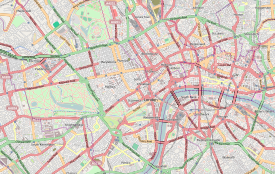Tower of London
| Tower of London | |
|---|---|
 The Tower of London, seen from the River Thames, with a view of the water-gate called "Traitors' Gate" | |
| Location | London Borough of Tower Hamlets London, EC3 |
| Coordinates | 51°30′29″N 00°04′34″W / 51.50806°N 0.07611°W |
| Area | Castle: 12 acres (4.9 ha) Tower Liberties: 6 acres (2.4 ha) |
| Height | 27 metres (89 ft) |
| Built | White Tower: 1078 Inner Ward: 1190s Re-built: 1285 Wharf expansion: 1377–1399 |
| Visitors | 2,741,126 (in 2016)[1] |
| Owner | Queen Elizabeth II in right of the Crown[2] |
| Type | Cultural |
| Criteria | ii, iv |
| Designated | 1988 (12th session) |
| Reference no. | 488 |
| Country | United Kingdom |
| Region | Europe and North America |
Listed Building – Grade I | |
Listed Building – Grade II | |
The Tower of London is a Norman stone fortress in London, England. It stands on the bank of the River Thames, in the oldest part of the city.
It is a UNESCO World Heritage Site.[3]
History
[change | change source]The fortress was built by William the Conqueror, King William I, starting in 1078. The moat was built by Richard I, using water diverted from the River Thames.
The Tower had many uses. Its main function was to protect Norman rule in the years after the conquest. It was a prison, and a place of execution. Today, the Crown Jewels are kept there. This is the collection of jewels owned by the British state, and sometimes worn by the monarch. There is also a museum of armour.
Only the most important people were executed (by axe) inside the Tower of London. Among the most famous were:
- George, Duke of Clarence (1478)
- Anne Boleyn, Queen of England (1536) wife of King Henry VIII
- Thomas Cromwell, 1st Earl of Essex (1540)
- Margaret Pole, Countess of Salisbury (1541)
- Jane Boleyn, Viscountess Rochford (1542)
- Catherine Howard, Queen of England (1542), wife of King Henry VIII
- Lady Jane Grey (1554)
- Robert Devereux, 2nd Earl of Essex (1601)
The Tower of London has a collection of ravens, large black birds of the Crow family. They are taken care of by the staff who work there. The ravens' wing feathers are kept short so they cannot fly away. This is because a legend (story) says that if the ravens leave the Tower, the Tower and the Kingdom will fall.
The closest Underground station to the Tower of London is Tower Hill.
Escape attempts
[change | change source]Ranulf Flambard: 1100, successfully escaped.
Gruffudd ap Llywelyn ap Iorwerth: 1244, fell from the tower and died during his escape attempt.
Related pages
[change | change source]References
[change | change source]- ↑ "Visits made in 2016 to visitor attractions in membership with ALVA". Association of Leading Visitor Attractions. Retrieved 20 August 2017.
- ↑ "History". Historic Royal Palaces. Retrieved 22 July 2013.
- ↑ UNESCO, "Tower of London"; retrieved 2012-4-19.
Other websites
[change | change source] Media related to Tower of London at Wikimedia Commons
Media related to Tower of London at Wikimedia Commons- Tower of London website




